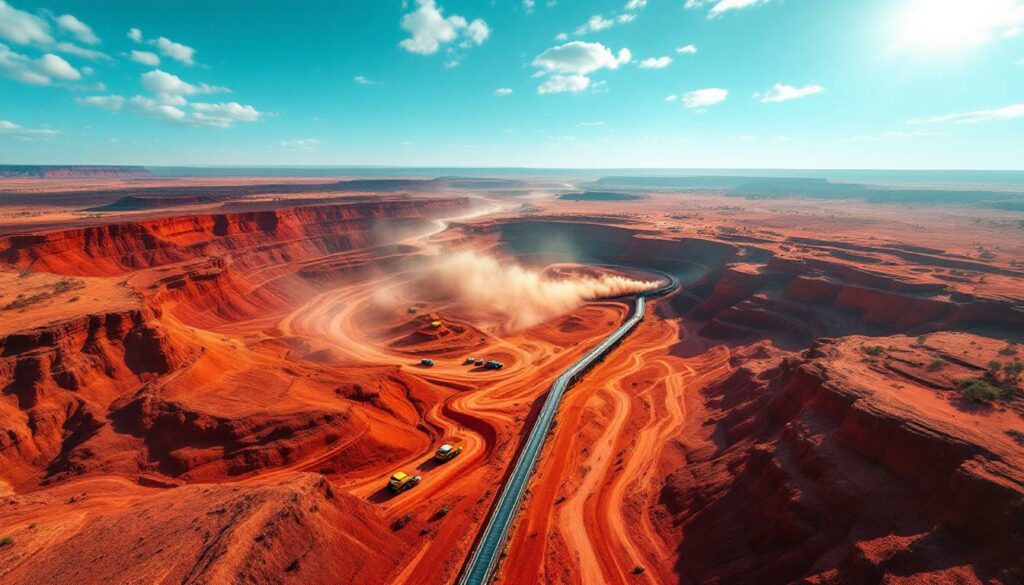Western Range: Rio Tinto's $2 Billion Iron Ore Investment Transforms Pilbara Mining
The Pilbara region has welcomed a significant new development with Rio Tinto and China Baowu Steel Group officially opening the Western Range iron ore project. This $2 billion joint venture represents a strategic investment in Australia's resources sector, designed to sustain production at the historic Paraburdoo hub for approximately two decades.
Situated in Western Australia's resource-rich Pilbara region, Western Range will add up to 25 million tonnes of annual iron ore capacity to Rio Tinto's operations, reinforcing Australia iron ore leader position in global iron ore production.
What is the Western Range Iron Ore Project?
The Western Range project represents a landmark $2 billion investment in Australia's iron ore sector, jointly developed by Rio Tinto (54%) and China Baowu Steel (46%). Located in Western Australia's resource-rich Pilbara region, this strategic development aims to sustain production at the nearby Paraburdoo processing hub, which has been operational since 1972.
"Western Range ensures the longevity of our Paraburdoo operations, which have been a cornerstone of our Pilbara production for over five decades," said Jakob Stausholm, Rio Tinto's CEO at the official opening ceremony.
The project adds significant capacity to Rio Tinto's iron ore operations, with the ability to process up to 25 million tonnes annually. This additional output will help maintain Australia's competitive position in global iron ore markets while ensuring continuous supply for steelmakers worldwide.
Key Project Components
The Western Range development includes several sophisticated technical elements:
- Primary crusher installation: Featuring state-of-the-art crushing technology to process extracted ore efficiently
- 18-kilometer conveyor system: An engineering achievement connecting the mine to the existing Paraburdoo processing infrastructure
- Integration with existing infrastructure: Designed to maximize operational efficiency and minimize environmental footprint
- First ore processing: Scheduled for March 2025
- Budget performance: Completed on time and within budget parameters, a significant achievement for a project of this scale
The project's successful delivery highlights Rio Tinto's project management capabilities, particularly important as the company advances multiple replacement projects across the Pilbara to maintain production levels.
Why is Western Range Strategically Important?
Western Range serves multiple strategic purposes for both Rio Tinto and the broader Australian economy. As a key replacement project in Rio Tinto's portfolio, it forms part of a comprehensive strategy to maintain the company's production capabilities while extending the life of existing infrastructure.
"The Pilbara is the engine room of the nation's economy," noted Federal Resources Minister Madeleine King. "Projects like Western Range will keep that engine running for future generations of Australians."
Economic Significance for Western Australia
The project delivers substantial economic benefits to Western Australia and the broader Australian economy:
- Employment sustainability: Ensures operational continuity for Paraburdoo's 880-strong workforce
- Diverse employment models: Supports both residential and fly-in, fly-out employment arrangements
- Revenue generation: Iron ore exports generated A$136 billion for Western Australia in 2023–24
- Royalty contributions: WA iron ore royalties totaled A$11.2 billion in 2024
- Regional development: Reinforces the Pilbara's status as a critical resource hub
Western Australian Premier Roger Cook emphasized the project's importance: "The opening of Western Range is a significant achievement, and its importance to Western Australia's economy cannot be overstated."
Operational Significance for Rio Tinto
For Rio Tinto, Western Range represents a critical component of its broader production strategy:
- Extends productive life: Adds approximately 20 years to the Paraburdoo hub, operational since 1972
- Reserve replacement: Forms part of Rio Tinto's comprehensive Pilbara replacement strategy to offset depleting resources
- Infrastructure optimization: Leverages existing processing facilities, maximizing return on previous investments
- Portfolio complementation: Works in concert with other development projects including Brockman Syncline 1
- Production sustainability: Supports ongoing developments at Hope Downs 1 and West Angelas
This strategic approach ensures Rio Tinto can maintain consistent production levels while managing capital efficiency—crucial factors in the cyclical iron ore market.
How Does Western Range Reflect Indigenous Engagement Progress?
The Western Range project marks a significant milestone in Rio Tinto's approach to Indigenous engagement, particularly following the company's widely criticized destruction of Juukan Gorge in 2020. This development represents Rio Tinto's first implementation of a co-designed Social, Cultural and Heritage Management Plan (SCHMP) with the Yinhawangka People, traditional custodians of the land.
Partnership with Yinhawangka Traditional Owners
The partnership with the Yinhawangka People establishes a new benchmark for Indigenous engagement in mining projects:
- Co-designed heritage protection: Collaborative development of protocols to identify and protect culturally significant areas
- Knowledge integration: Incorporation of traditional knowledge into environmental management practices
- Ongoing consultation framework: Regular dialogue and decision-making processes that respect Yinhawangka perspectives
- Cultural recognition: Acknowledgment of the Yinhawangka People's deep connection to country extending back thousands of years
- Employment and business opportunities: Targeted programs to increase Indigenous participation
Robyn Hayden, Chairperson of the Yinhawangka Aboriginal Corporation, described the project as representing "a significant shift in how mining companies recognize and protect our cultural heritage."
Industry Implications
The approach taken at Western Range has broader implications for the mining industry evolution:
- Post-Juukan reforms: Demonstrates Rio Tinto's organizational learning and reformed practices following the 2020 controversy
- Sector benchmarking: Establishes new standards for Indigenous engagement that may influence industry-wide practices
- Operational risk mitigation: Reduces potential for cultural heritage-related project delays through early and meaningful engagement
- Social license enhancement: Rebuilds trust with Indigenous communities and other stakeholders
- Regulatory alignment: Anticipates evolving regulatory requirements for Indigenous consultation
This collaborative approach balances commercial development with cultural heritage protection, potentially creating a model for future resource projects across Australia.
What Investment is Rio Tinto Making in the Pilbara?
The Western Range project is part of a substantial capital investment program by Rio Tinto in the Pilbara region, reflecting the company's long-term commitment to Australian iron ore production and its confidence in future market demand.
Current and Planned Investment
Rio Tinto's investment strategy in the Pilbara is comprehensive and forward-looking:
- $13 billion planned investment: Targeted for the Pilbara between 2025-2027
- $8.5 billion previous expenditure: Invested over the preceding three years (2022-2024)
- Multiple replacement projects: Development of various mines to maintain production as older operations deplete
- Infrastructure optimization: Upgrades to rail, port, and processing facilities to maximize efficiency
- Technology integration: Implementation of autonomous systems and digital technologies to enhance productivity
This sustained investment underscores the Pilbara's continuing importance to Rio Tinto's global portfolio and the company's commitment to maintaining its position as a leading iron ore producer.
Future Development Pipeline
Beyond Western Range, Rio Tinto is advancing several significant projects:
- Rhodes Ridge development: Pre-feasibility study progressing, targeting 40 million tonnes annual capacity
- 2030 production target: First ore from Rhodes Ridge expected by the end of the decade
- Resource scale: Rhodes Ridge holds approximately 6.8 billion tonnes of high-grade iron ore reserves
- Transformational potential: One of the world's largest undeveloped iron ore deposits
- Infrastructure integration: Will require significant expansions to existing rail and port facilities
The Rhodes Ridge project in particular represents a substantial growth opportunity for Rio Tinto, potentially allowing the company to not just maintain but expand its production capacity in the coming decades.
"Our investment in the Pilbara reflects our confidence in the long-term fundamentals of iron ore and our ability to deliver value through world-class operations," noted Rio Tinto's Iron Ore Chief Executive.
What Does Western Range Mean for Australia-China Relations?
The joint venture between Rio Tinto and China Baowu Steel highlights the enduring economic relationship between Australia and China despite periodic diplomatic tensions. As China's largest steel producer, Baowu's significant investment in Australian resources demonstrates the mutual benefits that transcend geopolitical challenges.
Strategic Partnership Dynamics
The Western Range project illustrates several important aspects of the Australia-China economic relationship:
- Interdependence: China relies on Australian iron ore for approximately 70% of its imports, a critical input for its steel industry
- Investment continuity: Demonstrates ongoing Chinese willingness to invest in Australian resources despite diplomatic fluctuations
- Economic pragmatism: Business relationships persisting through political tensions
- Supply chain security: Ensures reliable iron ore supply for China's infrastructure and manufacturing sectors
- Mutual benefits: Revenue for Australia and resource security for Chinese steel production
Hu Wangming, Chairperson of China Baowu Steel Group, emphasized the project's significance beyond its commercial value: "Western Range showcases the strength and resilience of China-Australia economic ties, built on mutual interests and long-term vision."
Historical Context
The Western Range partnership builds on a foundation of previous successful collaborations:
- Channar precedent: Follows the model of the successful Channar joint venture between Rio Tinto and Sinosteel
- Evolution of engagement: Represents a more sophisticated partnership structure than earlier resource agreements
- Investment maturity: Demonstrates growing Chinese confidence in Australian mining investments
- Regulatory navigation: Successfully addressed foreign investment approval processes
- Industry integration: Reflects deeper integration of Australian resources into Chinese steel supply chains
These established relationships provide a buffer against short-term political tensions, highlighting the pragmatic approach both countries take toward their economic relationship in critical sectors.
How Does Western Range Support Australia's Economic Future?
The development of Western Range reinforces the Pilbara's position as a critical economic engine for Australia, generating substantial economic benefits at local, state, and national levels over an extended timeframe.
Government Perspectives
Government leaders have emphasized the project's significance:
- Western Australian Premier Roger Cook: "The opening of Western Range is a significant achievement, and its importance to Western Australia's economy cannot be overstated. Projects like this maintain our state's high standard of living."
- Federal Resources Minister Madeleine King: "The Pilbara is the engine room of the nation's economy. Projects like Western Range will keep that engine running for future generations of Australians."
These statements reflect the project's role in sustaining Australia's resources-led economic growth model.
Long-term Economic Benefits
Western Range will deliver multi-faceted economic advantages:
- Employment sustainability: Maintains 880 direct jobs at Paraburdoo operations
- Supply chain support: Creates additional indirect employment through equipment, logistics, and services
- Government revenue: Generates ongoing royalty and tax payments estimated at hundreds of millions annually
- Export earnings: Contributes to Australia's trade balance through iron ore exports
- Regional development: Supports communities and infrastructure in the Pilbara region
The 20-year operational lifespan provides economic certainty for the region, allowing for long-term planning and investment in supporting infrastructure and services.
What Other Iron Ore Projects is Rio Tinto Developing?
Western Range is one component of Rio Tinto's broader iron ore strategy, which includes multiple development projects across the Pilbara region to maintain and potentially expand production capacity.
Current Development Portfolio
Rio Tinto is advancing several key projects simultaneously:
- Brockman Syncline 1: Recently announced replacement project to sustain production levels
- Hope Downs 1: Ongoing sustaining developments to extend mine life
- West Angelas: Expansion projects to increase productivity at existing operations
- Paraburdoo: Continuous improvement initiatives alongside Western Range development
- Gudai-Darri: Optimization of this recently commissioned intelligent mine
These projects collectively form a comprehensive approach to resource development, ensuring Rio Tinto can maintain consistent production while managing capital efficiency.
Strategic Production Objectives
Rio Tinto's project pipeline serves multiple strategic purposes:
- Production consistency: Maintaining the company's 320-330 million tonne annual output
- Reserve replacement: Offsetting natural depletion at aging operations
- Quality optimization: Focusing on higher-grade deposits to meet evolving market demands
- Infrastructure utilization: Maximizing returns from existing rail, port, and processing assets
- Competitive positioning: Maintaining cost advantages against global competitors
By developing multiple projects concurrently, Rio Tinto creates operational flexibility and reduces dependency on any single development, enhancing the resilience of its Pilbara production system.
What Does This Mean for Global Iron Ore Markets?
The Western Range development contributes to stability in global iron ore markets by sustaining production from one of the world's most reliable supply regions. This has significant implications for supply chains, pricing dynamics, and competitive positioning among major producers.
Market Context and Implications
Western Range influences several aspects of the global iron ore landscape:
- Supply reliability: Reinforces Australia's position as the world's leading iron ore exporter (40% of global exports)
- Market balance: Helps offset production fluctuations from other major producing regions like Brazil
- Price stability: Contributes to predictable supply, potentially reducing price volatility
- Quality differentiation: Maintains availability of premium Pilbara blends preferred by many steelmakers
- Competitive dynamics: Strengthens Rio Tinto's position against rivals BHP and Vale
For steel producers globally, the project represents continued access to high-quality ore from a geopolitically stable region, an increasingly important consideration in supply chain planning.
Future Market Considerations
Looking ahead, Western Range will operate in an evolving market context:
- Decarbonization pressures: Growing preference for higher-grade ores that reduce emissions in steelmaking
- China's production plateau: Potential stabilization of Chinese steel output affecting iron ore demand insights
- Alternative steelmaking: Emergence of hydrogen-based production potentially changing ore requirements
- Supply concentration: Continued dominance of major producers in global trade flows
- Price volatility factors: Weather events, regulatory changes, and geopolitical tensions affecting iron ore price trends
Industry Analysis Note: While the iron ore market experiences cyclical pricing, sustained investment by major producers like Rio Tinto indicates confidence in long-term demand fundamentals despite short-term fluctuations.
FAQs About the Western Range Iron Ore Project
When did construction of Western Range begin?
Construction commenced following final investment decision approval, with the development completed on schedule to allow first ore processing in March 2025.
How many jobs does the Western Range project support?
The project provides operational continuity for Paraburdoo's 880-strong workforce, including both residential and fly-in, fly-out employees.
What is the ownership structure of Western Range?
Western Range is a joint venture with Rio Tinto holding a 54% stake and China Baowu Steel holding the remaining 46%, reflecting a continuation of successful partnership models in the Pilbara.
How does Western Range connect to existing operations?
The project includes an 18-kilometer conveyor system that connects to the existing Paraburdoo processing plant, allowing for efficient integration with established infrastructure and minimizing the need for duplicate facilities.
What is the expected production capacity of Western Range?
The mine will add up to 25 million tonnes per year of new iron ore capacity to Rio Tinto's operations, helping maintain the company's overall production profile in the Pilbara.
How long is Western Range expected to operate?
The development is designed to sustain production at the Paraburdoo hub for up to two decades, extending the life of operations that began in 1972.
What makes the indigenous engagement approach at Western Range significant?
Western Range is Rio Tinto's first project to implement a co-designed Social, Cultural and Heritage Management Plan with Traditional Owners (the Yinhawangka People), representing an evolution in the company's approach following the Juukan Gorge controversy.
How does Western Range fit into Rio Tinto's overall Pilbara strategy?
The project is part of Rio Tinto's broader replacement strategy, working alongside developments at Brockman Syncline 1, Hope Downs 1, and West Angelas to maintain production levels as older mines deplete.
What role does China Baowu play in the project?
As China's largest steel producer, Baowu's 46% investment represents the strategic importance of securing reliable iron ore supply chains and highlights the enduring economic relationship between Australia and China.
How does Western Range compare to Rio Tinto's Rhodes Ridge development?
While Western Range adds 25 million tonnes of annual capacity, the future Rhodes Ridge project is targeting 40 million tonnes annually by 2030 and represents one of the world's largest undeveloped iron ore deposits with important implications for [iron ore forecast 2025](https://discoveryalert.com.au/news/iron-ore-price-
Looking for Early Alerts on Major Mineral Discoveries?
Stay ahead of the market with Discovery Alert's proprietary Discovery IQ model, delivering instant notifications when significant ASX mineral discoveries are announced. Explore why historic discoveries like De Grey Mining (DEG) can generate substantial returns by visiting the dedicated discoveries page and begin your 30-day free trial today.




